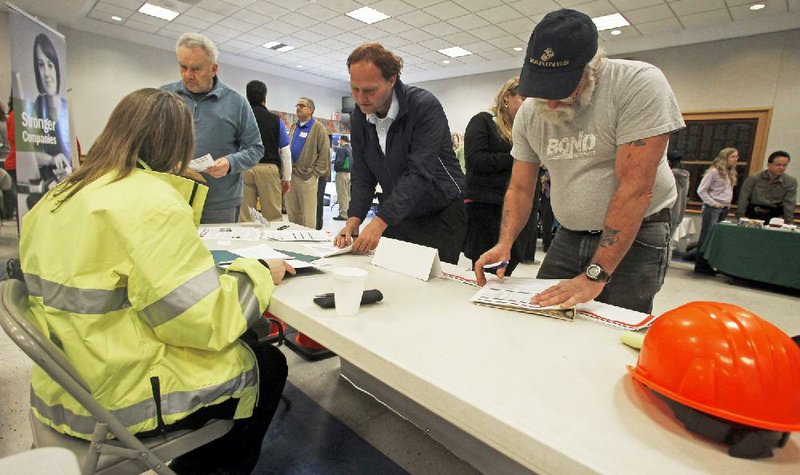WASHINGTON - The number of Americans seeking unemployment benefits increased just 4,000 last week to a seasonally adjusted 352,000. The slight gain kept applications at a level consistent with solid hiring and suggests March’s sluggish hiring may be temporary.
The Labor Department report released Thursday also noted that the four-week average, a less volatile measure, rose only 2,750 to 361,250.
Applications are a proxy for layoffs. They jumped three weeks ago to a four month high, but then plummeted the next week. The sharp fluctuations reflected volatility around the Easter holiday, department officials said. Overall, applications have declined slightly since January.
“It appears that the modest growth of the economy is continuing to support modest improvement in labor market conditions,” said Jim Baird, chief investment officer at Plante Moran Financial Advisors.
Job growth slowed sharply in March. Employers added 88,000 jobs last month, much lower than the average monthly gain of 220,000 from November through February.
The drop in applications over the past two weeks has led many economists to predict that the job market rebounded this month. Joseph LaVorgna, an economist at Deutsche Bank, said last week’s level of applications is consistent with his forecast for 190,000 jobs created in April.
And a Federal Reserve report released Wednesday suggested the job market performed better in March than the government’s employment report indicated. The Beige Book, which is based on anecdotal information, said the job market was unchanged or slightly better in the period from late February through early April.
Declines in applications signal that companies are laying off fewer workers. But layoffs are only half of the equation. Businesses also need to be confident enough in the economic outlook to add more jobs.
More than 5.1 million people received benefits in the week ended March 30, the latest data available. That was about 125,000 fewer than the previous week.
The U.S. unemployment rate fell to 7.6 percent in March, down from 7.7 percent in February. Still, the drop occurred because more people out of work stopped looking for jobs. The government doesn’t count people as unemployed unless they are actively looking for work.
The economy is expected to grow at a much quicker pace in the January-March quarter than in the final three months of last year. Most economists forecast growth could top an annual rate of 3 percent in the first quarter, up from just 0.4 percent in the fourth quarter.
But many analysts now expect growth will slow in the April-June quarter, mostly because across-the-board government spending cuts kicked in March 1. That may have made some businesses nervous about hiring last month.
A second report released Thursday measuring the U.S. economy’s future health declined slightly in March, signaling that growth could slow this spring.
The Conference Board said its index of leading indicators dipped 0.1 percent last month to 94.7. That’s the first decline after three months of gains. The gauge is designed to anticipate economic conditions three to six months out.
“We’re seeing economic growth cool off a little bit after a strong start to the year,” said Mark Vitner, a senior economist at Wells Fargo Securities LLC in Charlotte, N.C. “There’s no question that growth is going to remain in positive territory.”
Declines in consumer confidence, housing permits and new orders for manufactured goods pushed down the index.
Higher stock prices and a larger spread between long term and short-term interest rates offset the decline.
“Data for March reflect an economy that has lost some steam,” said Ken Goldstein, an economist at the Conference Board.
Across-the-board government spending cuts are likely weighing on growth, Goldstein said. Economists forecast the cuts will shave a half-percentage point from growth this year.
The private sector is also struggling, Goldstein added. “The biggest challenge remains weak demand, due to nervous consumer sentiment and slow income growth,” he said.
But overall, “the leading indicator still points to a continuing but slow growth environment,” Ataman Ozyildirim, also an economist at the Conference Board, said. The board is a research group with a mostly business membership.
Information for this article was contributed by Christopher S. Rugaber of The Associated Press and Jeanna Smialek and Michelle Jamrisko of Bloomberg News.
Business, Pages 25 on 04/19/2013

